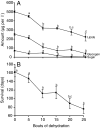Repeated bouts of dehydration deplete nutrient reserves and reduce egg production in the mosquito Culex pipiens
- PMID: 20675546
- PMCID: PMC2912756
- DOI: 10.1242/jeb.044883
Repeated bouts of dehydration deplete nutrient reserves and reduce egg production in the mosquito Culex pipiens
Abstract
In this study of the mosquito, Culex pipiens, we examined the impact of multiple bouts of dehydration and rehydration on survival, depletion of metabolic reserves and egg production in both non-diapausing and diapausing females. Mosquitoes provided with access to sugar during rehydration survived longer than those allowed to rehydrate without sugar, and their survival was similar to that of mosquitoes of the same age that were not dehydrated. Among mosquitoes not provided with sugar, each dehydration bout reduced the mosquito's dry mass - an effect likely to be due to the utilization of carbohydrates and lipid reserves. The toll on glycogen and lipid reserves is likely to be especially costly for diapausing mosquitoes that are dependent on these stored reserves for winter survival. Egg production in both non-diapausing and post-diapausing C. pipiens was also reduced in response to multiple bouts of dehydration. Although egg quality was not compromised, the number of eggs produced was reduced. Both non-diapausing and diapausing females can compensate for the nutrient loss due to dehydration by sugar feeding but the opportunity to feed on sugar is likely to be rarely available in the overwintering habitat of diapausing females, thus the impact of dehydration may be especially pronounced in overwintering populations of C. pipiens.
Figures







References
-
- Albers M., Bradley T. J. (2004). Osmotic regulation in adult Drosophila melanogaster during dehydration and rehydration. J. Exp. Biol. 207, 2313-2321 - PubMed
-
- Bale J. S., Worland M. R., Block W. (2001). Effects of summer frost exposures on cold tolerance strategy of the sub-Antarctic beetle. J. Insect Physiol. 47, 1161-1167 - PubMed
-
- Benoit J. B. (2010). Water management by dormant insects: comparisons between dehydration resistance during estivation and winter diapause. In Progress in Molecular and Subcellular Biology, Vol. Estivation (ed. Navas C., Eduardo J.), pp. 209-230 Berlin: Springer; - PubMed
-
- Benoit J. B., Denlinger D. L. (2007). Suppression of water loss during adult diapause in the northern house mosquito, Culex pipiens. J. Exp. Biol. 210, 217-226 - PubMed
-
- Benoit J. B., Yoder J. A., Rellinger E. J., Ark J. T., Keeney G. D. (2005). Prolonged maintenance of water balance by adult females of the American spider beetle, Mezium affine Boieldieu, in the absence of food and water resources. J. Insect Physiol. 51, 565-573 - PubMed
Publication types
MeSH terms
Substances
Grants and funding
LinkOut - more resources
Full Text Sources

